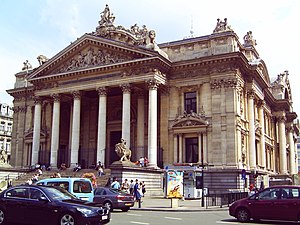| Stock market of Brussels (Photo credit: Wikipedia) |
New York, Feb.6, stock investing .- The cash outflows in the largest junk bond ETFs such as iShares iBoxx High Yield Corporate Bond (NYSEArca: HYG) and SPDR Barclays High Yield Bond (NYSEArca: JNK) have analysts wondering whether the pullback is a healthy correction after a strong rally, or a sign of something more serious in credit markets.
“The sudden downturn in high-yield corporate bonds should give investors a wake-up call,” writes Michael Kahn atBarron’s. “While it is not unusual for any market to pull back after a few months of strong gains, this market’s departure from other so-called ‘risk assets’ could be an early warning that the recent strong run in the stock market is in jeopardy.”
Also, some are questioning whether the soaring popularity of corporate bond ETFs could facilitate a violent downturn if investors rush for the exits at once as interest rates rise.
“[M]utual funds and ETFs together are responsible for a big portion of the marginal flows into corporate credit markets in recent years,” writes Matthew Boesler atBusiness Insider, citing research from Citi strategist Stephen Antczak. “Mutual funds now account for $1.7 trillion of the market, up 69% from the first quarter of 2009, and ETFs are responsible for $200 billion – up 328% in the same time period.”
The iShares iBoxx High Yield Corporate Bond (NYSEArca: HYG) and SPDR Barclays High Yield Bond (NYSEArca: JNK) recorded net outflows of $460.9 million and $347.5 million, respectively, amid last week’s sell-off, and trading volume has been rising. Still, the outflows aren’t significantly large when considering how big these ETFs are, and the massive inflows they’ve attracted over the past year from yield-hungry investors.[High-Yield, Emerging Market Bond ETFs Lead Outflows on Pullback]
Corporate bond mutual funds and ETFs have allowed individual investors to easily access the sector. If Treasury yields rise this year and hurt the corporate debt market, these investors could scale back, “creating forced sellers,” Antczak notes.
“Forced selling is a problem when there is no one else to take the other side of the trade. Making the situation worse is the amount of risk investors in corporate credit have taken on as of late,” Boesler writes at Business Insider.
“If mutual funds and ETFs are forced to sell, particularly given that the Street is still not willing to boost risk positioning, who will take the other side?” Antczak wonders. The answer: “Perhaps no one, at least not until valuations cheapen meaningfully.”
“The recent slide in high-yield bonds should give Wall Street investors reason to be on high alert,” writes Tomi Kilgore for WSJ.com’s MarketBeat blog, referring to the pullback in HYG, the junk debt ETF.
“High-yield bonds and stocks can send different messages over the short term. But when the HYG diverges lower like it has been over the past few weeks, investors have reason to be concerned,” he added. “While the HYG’s fall could be seen by some as cash potentially leaving bonds for riskier assets–potentially a bullish sign–equity investors shouldn’t count on that money finding its way into higher-risk stocks … While the HYG’s recent slide is no guarantee a stock selloff is imminent, bulls who have enjoyed a nice run over the past few months may not want to tempt fate.”
iShares iBoxx High Yield Corporate Bond
Full disclosure: Tom Lydon’s clients own JNK and HYG.
The opinions and forecasts expressed herein are solely those of John Spence, and may not actually come to pass. Information on this site should not be used or construed as an offer to sell, a solicitation of an offer to buy, or a recommendation for any product. …


No comments:
Post a Comment